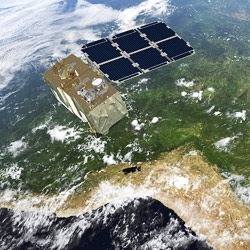Sentinel-2
Dedicated to supplying data for Copernicus services, Sentinel-2 is carrying a range of technologies, such as multi-spectral imaging instruments for land, ocean and atmospheric monitoring. It’s innovative wide swath multispectral imager is delivering high-resolution optical images for land monitoring, emergency response and security services. The satellite carries a multispectral imager with a swath of 290 km. The imager provides a versatile set of 13 spectral bands spanning from the visible and near infrared to the shortwave infrared, featuring four spectral bands at 10 m, six bands at 20 m and three bands at 60 m spatial resolution.
Image: ESA/ATG medialab
Sentinel-1
The Sentinel-1 imagery is provided by two polar-orbiting satellites, operating day and night performing C-band synthetic aperture radar imaging, enabling them to acquire imagery regardless of the weather. Main applications are for monitoring sea ice, oil spills, marine winds, waves & currents, land-use change, land deformation among others, and to respond to emergencies such as floods and earthquakes. The identical satellites orbit Earth 180° apart and at an altitude of almost 700 km, offering a global revisit time of six days. Sentinel-1’s radar can operate in four modes.
Image: ESA
Landsat
The Landsat program is the longest running enterprise for acquisition of satellite imagery of Earth, running from 1972. The most recent, Landsat 8, was launched on February 11, 2013. The images are a unique resource for global change research and applications in agriculture, cartography, geology, forestry, regional planning, surveillance and education. Landsat 8 data has eight spectral bands with spatial resolutions ranging from 15 to 60 meters; the temporal resolution is 16 days.



